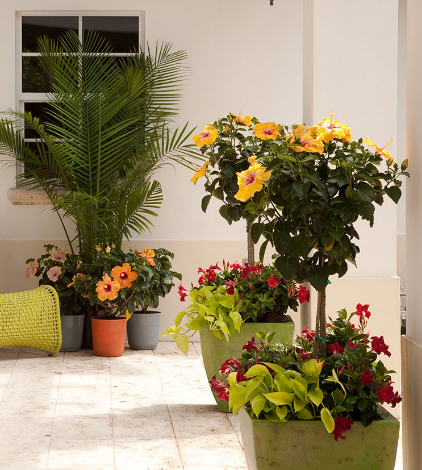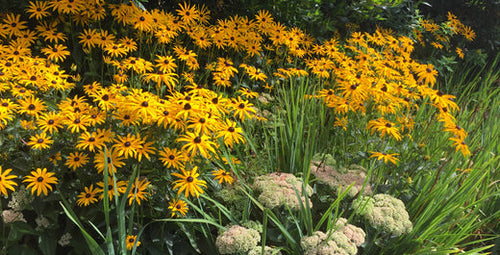
Artemisia
Silver-leaf plants like artemisia are some of the most valuable in the garden design world because they’re true neutrals. They look good paired with anything, so you can incorporate silvery plants anywhere in your landscape or container gardens. Artemisia varieties, such as silvermound (shown here), have fine-textured foliage that adds a soft, elegant look to your yard.
Use Artemisia for:
Effective in mass plantings and drifts in garden beds and borders, use it create a sense of continuity across your yard. A sun-loving perennial in Zones 4-8, you can also enjoy its tidy form as an annual in hotter or colder Zones.

Blue Fescue
There are scores of ornamental grasses to choose from, but blue fescue is one of the best if you’re looking for the silvery-blue look. One best thing about silvery-blue foliage is that, from a distance, it seems to recede from view. So planting it at the far end of your yard can help your space feel larger.
Use Blue Fescue for:
Because it doesn’t spread via runners, blue fescue stays in tidy mounds, making it an excellent choice for creating a fun, geometric look when used en masse. A perennial for sunny spots in Zones 4-8, blue fescue is also small enough that you can enjoy it in container gardens with other plants like lavender.

Dianthus
Most folks love dianthus for its showy, fragrant flowers. I love the silvery leaves that many varieties show. The foliage keeps the plant attractive even after the flowers fade, a trait I’ve often relied on for gardens I’ve designed. When dianthus blooms, its fine-textured, grassy-looking leaves are an ideal accent to the bright flowers.
Use Dianthus for:
Because it’s low and mounding, dianthus is perfect for the front of the border. Plant it along sunny pathways where you can enjoy its good looks up close and the fragrance when it’s in bloom. There are annual and perennial varieties; do your research to make sure the type you select is right for your climate.

Dichondra ‘Silver Falls’
A fabulously elegant choice to gracefully spill over the side of container gardens, Dichondra ‘Silver Falls’ almost appears to glow at dusk and dawn. You’ll find most silver-leaf plants have this effect, so they’re ideal pots and planters in the outdoor spaces you spend time in as the sun goes down.
Use Dichondra ‘Silver Falls’ for:
While it excels in container gardens, you can also enjoy Dichondra ‘Silver Falls’ as an annual groundcover in sunny beds and borders. You’ll love its low-maintenance nature. Because it hugs the earth, you can use it as an edging plant or underplanting beneath taller annuals, perennials, or shrubs.
Learn more about groundcovers.

Dusty Miller
Perhaps the most versatile annual of all time, dusty miller has textural foliage covered in soft, silvery-gray hairs. It makes an elegant pairing in cool color schemes with shades of blue, lavender, pink, and white. You can plant dusty miller with practically anything, from petunias to snapdragons to annual lobelia, to great effect.
Use Dusty Miller for:
Add dusty miller to summer container gardens where you can count on it to hold up to heat and periods of dry weather. It’s particularly well suited to growing with other heat lovers, including angelonia, scaevola, and annual vinca.

Echeveria
Echeveria and other succulents are loved for their low water needs. Many varieties feature silvery foliage, and that’s a trait often indicative of drought resistance. Because most succulents have small root systems, they’re easy to tuck here and there throughout the yard and are a low-maintenance alternative to thirsty annuals.
Use Echeveria for:
It’s ideal in container gardens, either by itself or paired with other succulents. If your containers are situated in a spot that sees some rainfall, you may not need to water them at all. What could be easier? You can also enjoy them in a wide range of fun DIY projects, including vertical gardens, where the silvery foliage adds extra appeal.

Eucalyptus
There are dozens of eucalyptus varieties around, but one of the most common is Eucalyptus cinerea. An attractive tree, it features round leaves held tightly to the stems and a fast growth rate. Because it’s tropical, eucalyptus is treated as an annual in most areas of North America.
Use Eucalyptus for:
Because it grows fast, you can get eucalyptus in early spring and grow it into a small standard (tree) by summer to add formal style to your container gardens. Enjoy it on your deck, patio, porch, or balcony -- or in big containers farther back in your yard.

Lamb’s Ears
Many silvery plants (including lamb’s ear) get their silvery color from soft hairs. Just touch the leaves to see what I mean. This fuzzy feeling is functional: It helps reflect light off the foliage, keeping it cool in hot weather. It also creates a texture that many critters, including deer and rabbits, prefer to avoid. So stocking your yard up with fuzzy, silver-leafed plants may be one way to thwart animal pests.
Use Lamb’s Ear for:
A low-growing groundcover in Zones 4-9, you can enjoy lamb’s ear as an annual in colder or warmer zones. If you don’t have room for it to spread, try growing it in containers, where it plays well with most other plants. A favorite combination in our Trial Garden was Texas sage, lamb’s ear, and lavender.

Lavender
This versatile plant deserves a place in practically every garden. While most varieties show off silver-green foliage, look for selections like ‘Anouk Silver’ (shown here) that have extra silvery leaves. Lavender (Lavandula) has a lot to offer, including its fantastic fragrance, excellent heat and drought tolerance, and resistance to deer and rabbits. Like many other silvery-leafed plants, it prefers a spot with well-drained soil. One of the most common problems with lavender is that it can rot in wet soil.
Use Lavender for:
Grow it in container gardens where you can brush by and get a whiff of its relaxing scent. It’s also a must-have plant for butterfly and bee gardens, as pollinators like the flowers as much as we do.
Learn more with our guide to lavender!

Texas Sage
Texas sage is a tropical shrub that loves hot, dry weather. That makes it a good low-maintenance plant you don’t have to worry about keeping watered all the time. Its silvery-green foliage blends beautifully with other colors, and can be especially useful for toning down the look of a garden that has too many strong shades. It offers a cooling effect when paired with lots of red, orange, or yellow flowers and foliage.
Use Texas Sage for:
A group of three make a lovely backdrop on a busy deck or patio. Texas sage also works well in mixed containers where it’s surprisingly versatile. We think it’s as beautiful with red mounding mandevilla as it is silvery lamb’s ear.

Sedum
There are a lot of sedum varieties to choose from, and a number have wonderfully silvery- green or blue foliage (shown here is ‘Sunsparkler Dazzleberry’). You can enjoy sedum in garden beds and borders, as well as more specialized plantings, such as rock gardens. Mix and match different varieties to enjoy delightful textural contrasts along with their easy-care natures.
Use Sedum for:
Upright sedums are spectacular for late-summer and fall gardens, and also provide valuable food sources for migrating pollinators (like Monarch butterflies). Groundcover types can be used to create a low-water carpet of color in areas of your landscape. Most selections are hardy in Zones 4-9 and do best in full sun.

















